Best Old House Neighborhoods 2011: Waterfront
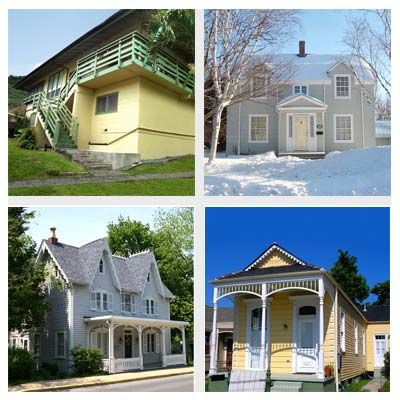
For the fourth year in a row, we’ve tracked down North America’s most timeless neighborhoods—places where lovingly crafted old houses have extraordinary pasts and unarguably promising futures. With help from our friends at Portland, Oregon-based PreservationDirectory.com—who distributed our nomination forms to more than 14,000 historical societies, neighborhood groups, and preservation nonprofits—we’ve assembled our biggest-ever list of off-the-beaten-path places that are worth eyeing for a great old home.
Here are our favorite waterside locales, where rivers, lakes, and oceans add a sparkle to the neighborhood.
Sitka, Alaska

The capital of Russian America, Sitka was the site of the handoff to the United States after the 1867 Alaska Purchase; it remained the region’s capital until 1906. Patinated copper spires atop the St. Michael’s Orthodox Cathedral overlook this community in the state’s southeastern region, which has an old-world feel rare for a West Coast town. Home to some 8,000 people, Sitka is located on Baranof Island, reachable only by boat or plane. But life here hardly feels like exile. The city’s satellite campus of the Juneau-based University of Alaska Southeast and renowned Sitka Fine Arts Camp (which recently took over the campus of the historic Shelton Jackson College) draw students and families from all over. With hiking trails dating to the 1930s and close proximity to Sitka National Historical Park, this place is also a playground for outdoors people young and old.
The Houses
A wet climate, foundation-compromising soil called muskeg, and relaxed building regulations prior to the 1950s pose challenges to aging homes in Alaska. Still, downtown is peppered with well-kept Queen Annes dating to the 1890s, originally inhabited by merchants and navy families, and Craftsman bungalows dating from 1910. Vernacular fisherman’s cottages are also common. The average price for a three- or four-bedroom house in good condition is around $400,000.
Why Buy Here?
Sitka is a great place to raise a family. “It’s a small community, but there’s a lot available to residents,” says Jay Kinsman, chair of the Sitka Historic Preservation Commission. Besides, Sitka is beating skyrocketing oil prices with the lowest electric rates in the state, powered by two hydroelectric power plants.
Among the best for: The West & Northwest, Waterfront, Family Friendly, Victorians, Small Towns, Outdoor Activities, History Happened Here
Ghost Historic District, Denver, Colorado
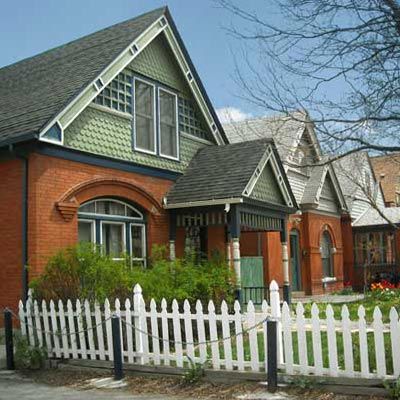
The Ghost Historic District pairs urban energy with small-town charm. It’s the newest area here to be recognized for its notable past—in 2010, it became Denver’s 50th historic neighborhood—but history isn’t what makes residents, a mix of young couples, families, and old-timers, feel at home. The shops, restaurants, and galleries lining 32nd Avenue, a main drag bordering the neighborhood to the north, make the area a pedestrian destination. Lower Downtown, known as LoDo, is a short bike or bus ride away, so those who work in the city’s business and cultural center have an easy commute. Nearby foothills offer convenient access to hiking and biking trails. A communal spirit pervades this area of some 200 homes in northwest Denver. Resident Marilyn Quinn found that out when her neighbors held a potluck party during a blizzard shortly after she moved in. “There are darn good cooks here,” she says.
The Houses
Most houses were built between the 1880s and 1920s. Old-house enthusiasts will find a variety of architectural styles, including Queen Anne, Dutch Colonial Revival, Tudor, Craftsman bungalows, Norman Cottages, and Foursquares. While prices average around $325,000, a 1,200-square-foot, two-bedroom, 1901 Victorian sold recently for $245,000.
Why Buy Here?
The Ghost Historic District has seen revitalization for more than a decade but buys remain. As part of Denver’s only ZIP code that hasn’t seen a market dip since 2007, this is the rare slice of city where a buyer can find a deal without fear of the bottom dropping out.
Among the best for: The Southwest, Bargains, Fixer-Uppers, Waterfront, Family Friendly, Cottages & Bungalows, Singles, First-Time Buyers, Victorians, Easy Commute
Tariffville Village, Simsbury, Connecticut
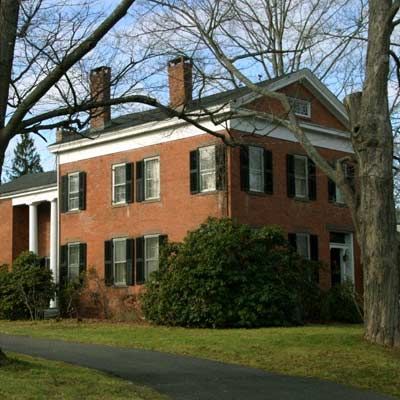
In Tariffville, locals are known to hold old-fashioned community cookouts or head to the Farmington River for tubing, kayaking, or rafting. But despite its many pleasures, few people outside Connecticut have ever heard of it. “This place has sort of been forgotten over the years,” says Chet Matczak, president of the Tariffville Village Association. “That’s one of the things that make it such a nice place to live.” The neighborhood of just 320 families is a pocket of Simsbury, about 11 miles northwest of Hartford. Thanks to its small-town New England charms, top-notch schools, and die-hard dedication to historic preservation. Simbsury was included on the National Trust for Historic Preservation’s exclusive “Dozen Distinctive Destinations” list in 2010. And Money magazine recently named it one of the Best Places to Live in America. We thought we’d add to the list by naming Tariffville one of the best neighborhoods to buy an old house, too.
The Houses
Greek Revivals and Gothic Revivals in Tariffville date back to the 19th century, while the late 1800s and early 1900s produced a whimsical array of Folk Victorians. Prices range from $180,000 for four-bedroom homes in disrepair (but with plenty of motivating character) to about $400,000 for large houses in beautiful condition.
Why Buy Here?
Tariffville is one of the few places where you can find a five-bedroom home for under $200,000. It’s an affordable hamlet for old-home lovers who want bang for their buck and for families buying for the first time and looking for access to quality education.
Among the best for: The Northeast, Bargains, Fixer-Uppers, Waterfront, Family Friendly, First-Time Buyers, Victorians, Small Towns, Outdoor Activities, Easy Commute
Milton, Delaware
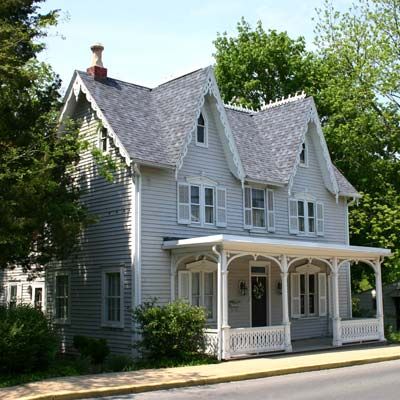
“We still have work to do,” says Melinda Huff, executive director of the Milton Historical Society about getting her little river town the recognition it deserves. Still, Milton has accomplished quite a bit already. Settled in the early 1680s, the town’s Historic District was listed National Register of Historic Places in 1982. Now Milton is in the process of nominating 240 more historic homes on the Register as well. Located near the state’s eastern shore at the Broadkill River’s head, Milton was, at various times, a 19th-century schooner-building center, the “Holly Capital of the World,” and a hotbed for buttonmaking. Nowadays it’s just a friendly small town, with nearly 2,000 parents, kids, grandparents, and young professionals who love Milton for summer’s sweet corn, cones from King’s Ice Cream, and other favorite summer pastimes, like fishing, canoeing, and gardening.
The Houses
About 40 percent of Milton’s homes have been restored, but there are still plenty of deals to be had. The Milton National Historic District includes 198 National Register—listed structures—among them Colonial, Federal, Greek Revival, Gothic Revival, Italianate, Second Empire, Queen Anne, and Colonial Revival homes—plus bungalows and vernacular styles. Some contain wide-plank floorboards taken from sailing vessels, stained-glass windows, hand carvings, and newel posts made of walnut or oak. Currently, an 1830s vernacular home with Federal characteristics is on the market for $200,000, though it needs a fair amount of restoration work.
Why Buy Here?
Anyone who enjoys boating, fishing, or maritime history—which is well documented at the Milton Historic Society’s museum—would feel pretty comfy here. Milton is also home to the famed Dogfishhead brewery, so you won’t ever have a hard time tracking down some fresh 90-Minute IPA or Chicory Stout.
Among the best for: The Northeast, Waterfront, Family Friendly, First-Time Buyers, Small Towns, Gardening, Walkability
South Historic District, Palatka, Florida
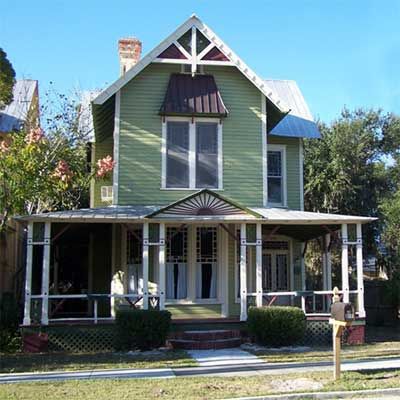
Once known as the “Gem of the St. Johns River,” this north-state city of 11,000 people was Florida’s original tourist destination. After a devastating fire in 1884, the farm town was swiftly rebuilt into a travelers’ hot spot, with eight first-class resorts, including the still existing James Hotel. Among the personalities who kicked back here: Jimmy Stewart, Gary Cooper, Babe Ruth, Teddy Roosevelt, Thomas Edison, and Harriet Beecher Stowe. The city still thrives today, with many young families, students at the Florida School for the Arts and St. Johns River State College, and, of course, retirees drawn by the welcoming weather (and a municipal golf course designed in 1925 by links lord Donald Ross). “It’s very Southern,” says Roberta Correa, president of the Palatka Southside Historic Neighborhood Association. “People are friendly, and the homes are quaint.”
The Houses
Palatka’s most desired houses line the gaslit streets of the South Historic District. Formerly known as “The Hammock,” this neighborhood below the downtown business district has long been one of Palatka’s most affluent. House styles include Colonial Revival, Greek Revival, Stick, Queen Anne, Folk Victorian, and Craftsman bungalows (including several Sears kit homes). A large, fully restored house with a river view can command $500,000. Smaller options needing TLC can go for as little as $60,000.
Why Buy Here?
The Southside Historic Neighborhood Association has a program that grants eligible homeowners up to $20,000 toward exterior restorations within the Historic District. The town’s Main Street revitalization campaign offers grants to new and existing businesses, meaning new jobs and amenities for residents and a boost to the real estate market.
Among the best for: The South, Bargains, Fixer-Uppers, College Towns, Waterfront, Retirees, Cottages & Bungalows, Victorians
Lower Nu’uanu, Honolulu, Hawaii
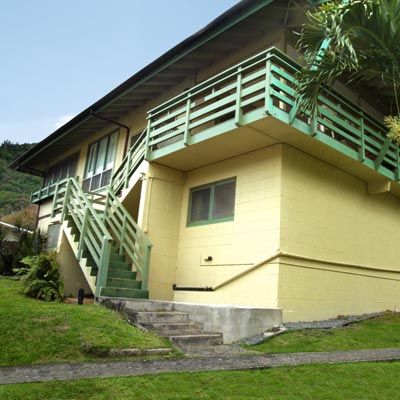
Perched above downtown Honolulu and directly below the rain forest, Lower Nu’uanu is a verdant old neighborhood in Oahu’s Nu’uanu Valley, where banyan trees stretch their limbs over the rooftops of carefully crafted houses, and residents enjoy Pacific breezes while taking front-porch catnaps. While people have lived in this area for centuries, most of Lower Nu’uanu’s development came with Hawaii’s annexation by the United States, in 1898. Soon after, hundreds of houses were built here for turn-of-the-century bankers and businessmen, who came from the mainland and Europe to seek their fortunes. Nowadays Lower Nu’uanu is drawing families, since it has one of the best public elementary schools on the island.
The Houses
Pre- and post-annexation Hawaii was heavily influenced by the California aesthetic—San Francisco was the closest mainland port—and many houses mimic California-style bungalows. Most are one or two stories and have single-wall construction. “Which is fine around here,” says Realtor Bryn Kaufman. “We have such a temperate climate that houses rarely require heating or air-conditioning.” The prices? Well, living in paradise will cost you at least $500,000 if you want a single-family home.
Why Buy Here?
Houses in Lower Nu’uanu are becoming more and more desirable, especially for former condo or apartment dwellers looking for a backyard for their kids to play in, or to plant a tropical garden. While downtown is just a 10-minute drive away, the valley feels far removed from the bustle of this 24/7 city of 375,000 and the millions of tourists who come here each year. Annual temperatures barely budge in these parts: Average highs are 80 to 89 degrees F, with lows of 60 to 75.
Among the best for: The West & Northwest, Waterfront, Family Friendly, Cottages & Bungalows, Gardening, Outdoor Activities, Easy Commute
Normal Hill, Lewiston, Idaho
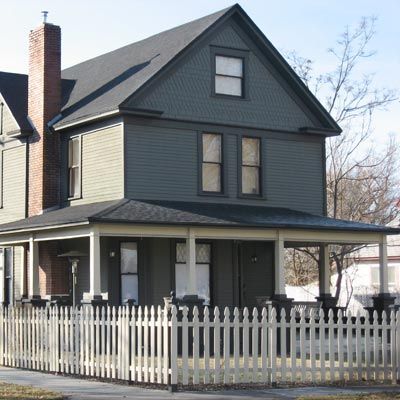
From the front porches of noble Victorian-era houses in Lewiston’s Normal Hill neighborhood, one can see cargo ships resting at the confluence of the Snake and Clearwater rivers, packed with Idaho wheat and ready to embark on export journeys to the Pacific Rim. Located in the Lewis Clark Valley, this city of about 33,000 has the distinction of being the West’s most inland seaport, some 465 miles from the coast. One of its most established—and beloved—old neighborhoods is Normal Hill, which got its name from Lewiston State Normal School, a 19th-century teacher’s college, and is now home to Lewis-Clark State College. LCSC offers the families and students who live here entertainment options from theatrical performances to basketball games. Locals can also easily walk down Fifth Avenue to the many bars, restaurants, and bakeries in downtown Lewiston.
The Houses
Homes here range from late-19th-century Queen Annes with river views to smaller Craftsman-style bungalows and Tudor Revival cottages, many of which have ample yards for gardening. We found a stunning 1,614-square-foot 1928 Craftsman with all its original built-in cabinetry—and a cool 1940s retro kitchen—for $120,000. Prices for river-view houses range from $130,000 up to $300,000, depending on size.
Why Buy Here?
Lewiston is part of the nation’s “banana belt,” meaning it has mild winters and hot summers. While we think it’s one of the best places in the country to find an old house, Outdoor Life magazine recently named it the Number 1 town in America for sportsmen, due to the amazing fishing and hunting opportunities offered by nearby Hells Canyon.
Among the best for: The West & Northwest, Bargains, Fixer-Uppers, Waterfront, Cottages & Bungalows, Singles, First-Time Buyers, Victorians, Gardening, Walkability
Atchison, Kansas
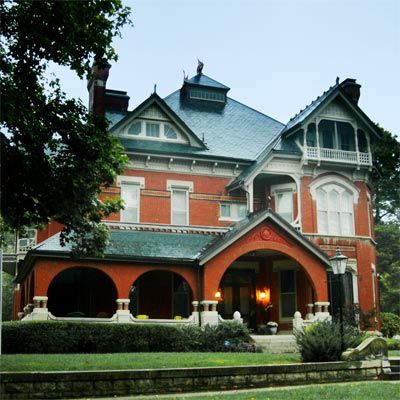
This northeast Kansas city (population 11,000) on scenic, rolling hilltops along the Missouri River retains its longtime downtown businesses, including prosperous locally owned hardware stores, bakeries, and mom-and-pop drug stores. The reason behind this refreshing scenario? Jobs—yes, real middle-class jobs! The area’s largest employers include a textile manufacturer, a hardware distributor, and Benedictine College, a Catholic liberal arts university of about 1,600 students that helps keep the city young and bustling. Tourism is a minor industry. There’s a haunted-house-tour trade based on a community of charismatic ghosts said to live in town. And Atchison is the birthplace of Amelia Earhart. The aviatrix’s family home houses a museum named for her, and a well-attended July festival celebrates her life and sky-pioneering accomplishments.
The Houses
Victorian-era houses, such as Queen Annes and Italianates, are par for the course, as are Colonial Revivals and bungalows. Many are situated along or near the Missouri River, and a handful are listed on the National Register of Historic Places. But it’s the property prices that will really lure old-house enthusiasts. A completely restored five-bedroom, 1900 Colonial Revival recently came on the market for $185,000. The house, located on a brick street, retains all its original—and, yes, exquisite—oak millwork.
Why Buy Here?
Got the restoration bug and a good eye? “We have an unusual market in Atchison,” says Realtor Scott Noyes. “You’ll often find a run-down $20,000 Victorian fixer-upper right down the street from a restored one that costs $200,000.” The city also has great public schools and safe streets, and is a 45-minute drive to Kansas City and Topeka.
Among the best for: The Midwest, Bargains, Fixer-Uppers, Waterfront, College Towns, Victorians, History Happened Here
Augusta, Kentucky
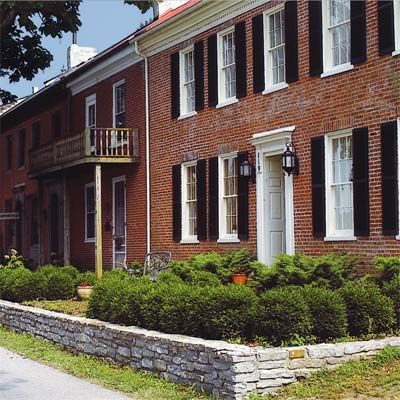
While Augusta has its share of antique shops and pubs, as well as top-notch restaurants that draw gourmands from all over the Bluegrass State, the most pleasurable thing to do may be to sit on a Riverside Drive bench and watch the Jenny Ann ferry glide back and forth across the Ohio River, as it has since 1798. Aside from pretty vistas, this city of 1,300 is known as the former home of “Mambo Italiano” singer Rosemary Clooney—whose house has been converted into a museum—and her dashing nephew, George, who attended Augusta Independent High School. “George’s parents still live here,” says Doug Padgett, Augusta’s director of tourism, “but when he comes back into town, he’s pretty discreet about it.”
The Houses
Riverside Drive is lined with stately 19th-century brick rowhouses built for the old town’s river merchants, who transported tobacco, livestock, and wine. Today, several small wineries call this part of Kentucky home. Both townhouses and detached houses here run from $250,000 to $400,000—the view makes them worth every penny—but more affordable houses can be found along Second and Fourth streets, where we spotted a completely renovated four-bedroom Queen Anne for $185,000.
Why Buy Here?
“This town hasn’t changed for a long time,” says Padgett. “You can still see the remnants of the good old days—the small mom-and-pop stores and the quiet streets lined with shade trees.” In recent years, Padgett has seen both commuters and retirees from Cincinnati, about 42 miles away, move here for the peace and quiet, and for the opportunity to virtually time travel to a simpler way of life.
Among the best for: The South, Waterfront, Retirees, Family Friendly, Victorians, Rowhouses, Walkability
Holy Cross, New Orleans, Louisiana
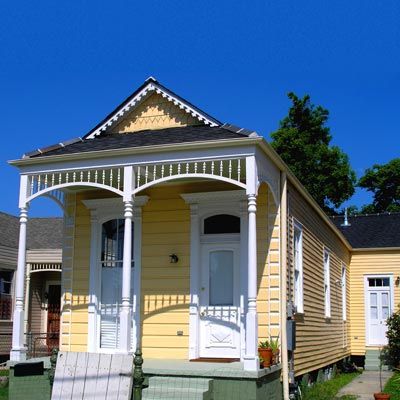
After being inundated by more than 10 feet of water from Hurricane Katrina, this historic working-class New Orleans neighborhood on the Mississippi River seemed about as likely to resurface as Atlantis. But soon after the water receded, a group of dedicated architects, residents, preservationists—and some guy named Norm Abram—ran to Holy Cross’s rescue, restoring the old shotgun houses and Creole Cottages and constructing sustainable housing. Norm and This Old House TV brought a flood-damaged 1892 shotgun back to life here in 2007. Now this old NOLA section, built on a former sugar-plantation site, is seeing new life, as families, artists, and, of course, jazz musicians, stake their claim on its increasingly bright future.
The Houses
These houses were built to last, with thick wood walls salvaged from old river barges, heavy hurricane shutters, and sturdy cypress woodwork. The area is dominated by 19th-century Creole Cottages and 19th- and early-20th-century single or double shotgun houses, some of which have second stories, called camelbacks, built on the rear. A gutted shotgun can be grabbed for as little as $19,000; restored, they tend to sell for $89,000 to $180,000, depending on size and location.
Why Buy Here?
Just over half of Holy Cross’s pre-Katrina population has returned, and the area is included in a program called Operation Comeback, run by the Preservation Resource Center of New Orleans. The organization has employed a revolving fund to restore dozens of houses here, selling them to first-time and repeat buyers. Talk of a new streetcar line and a new grocery store bode well for Holy Cross’s continuing comeback.
Among the best for: The South, Bargains, Fixer-Uppers, Waterfront, Singles, Gardening
Easton, Maryland
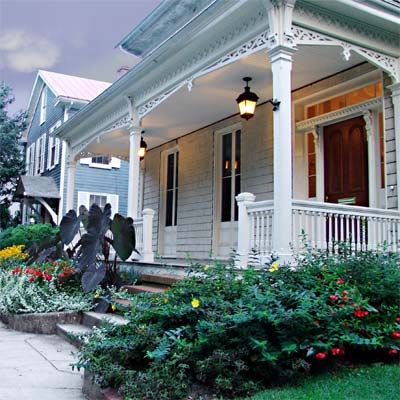
“I’m going to see Randy Newman at the Avalon downtown this month—and I’m walking to the theater,” says Beth Hansen, boasting about the walkability of her adopted hometown of Easton. Hansen, who moved here from Oakland, California, six years ago, also loves the town’s active arts community and gourmand-caliber restaurants, not to mention its indy coffee shops, clothing boutiques, and wine bars. Easton, which is home to about 14,000 people, has long been a hot spot for Washingtonians looking for second homes or retirement sweet spot. That makes sense: Downtown offers all of the cultural amenities big-city Beltway types demand, while Easton’s outlying areas on Chesapeake Bay provide boating, duck hunting, fishing, and some pretty inspiring natural scenery to boot.
The Houses
Like Hansen, many residents here choose to live in the downtown area’s historic Victorian-era houses, including Folk, Second Empire, and Queen Anne homes. We found a 3,480-square-foot Folk Victorian within walking distance of downtown for $129,000; a 4,175-square-foot, five-bedroom Second Empire farmhouse, located minutes from downtown on 2.69 acres of land, was selling for $346,000. Those who covet coastal views will find waterfront houses on Chesapeake Bay, about 15 minutes outside of town (expect to pay $700,000 and up for those properties).
Why Buy Here?
Prices were skyrocketing in Easton before the real estate bust, but now you can pick up a solid old house in town for less than $200,000. Easton is located 72 miles east of Washington, D.C., so it remains an excellent choice for second-home buyers. With its good schools and safe streets, it’s also ideal for families with children.
Among the best for: The Northeast, Waterfront, Family Friendly, Victorians, Small Towns, Walkability
Ipswich, Massachusetts
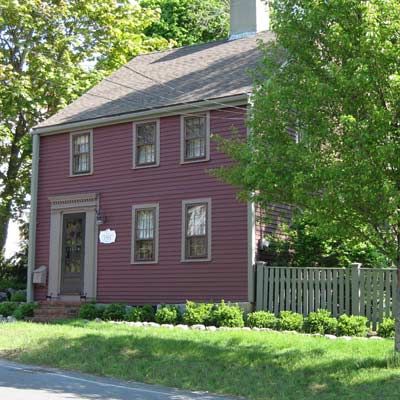
Some 30 miles northeast of Boston is the beachfront town of Ipswich, known to have inspired Theodore Wendel and other American Impressionist painters with its rolling hills, salt marshes, open farmlands, and classic maritime scenery. Ipswich is now home to almost 14,000 residents, including retirees, families, and everyone from working-class fishermen to well-known writers and artists. Environmentally focused preservation societies take great care to protect the town’s natural resources, while locals and visitors enjoy horseback riding on country trails, canoeing and kayaking on the Ipswich River, cavorting on Crane Beach’s white sands, and, of course, feasting on the famous Ipswich clams. Jean Moss, who conducts historic-home tours here, says, “I’ve never lived in a place where people loved their town so much.”
The Houses
Of the 180 historic houses here, 58 were built before 1725, making Ipswich the home of more First Period houses than any other U.S. community. Typically family owned and rarely found on the market, these early structures are mainly Postmedieval English timberframe dwellings featuring saltbox rearward extensions. Queen Anne and Italianate homes built around the turn of the 19th century are also here, and tend to go for around $600,000. On the lower end, a 3-bedroom 1928 Colonial Revival in need of gut renovation—and a hike from the town center—is listed for $169,900.
Why Buy Here?
You can live near the beach as a one-car family! Ipswich is one of only a few Boston-area seaside towns with its own train station, walkable from the town center.
Among the best for: The Northeast, Waterfront, Retirees, Family Friendly, Small Towns, Outdoor Activities, History Happened Here, Easy Commute, Walkability
Vicksburg, Mississippi
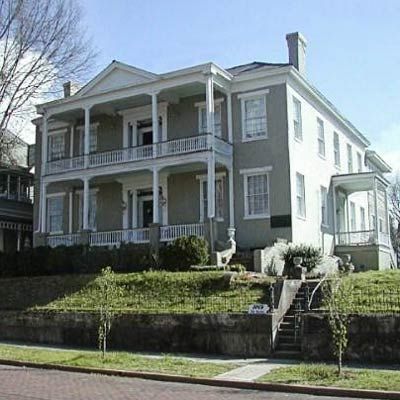
Vicksburg does indeed hold a place in Civil War history. You may recall from high-school history class that bloody 47-day siege, led by Ulysses S. Grant, who took control of the Mississippi River, splitting the Confederacy in two. This now-tranquil river city of 26,000, set on a bluff overlooking the Mississippi and Yazoo rivers, attracts almost a million battlefield visitors annually. It is also luring retirees and second-home buyers from as far away as Colorado and California. “People are figuring out that they can buy a plantation house with river views for about the same price as a regular old house elsewhere,” says Realtor Pam Powers. Besides the architectural offerings, they’re won over by Vicksburg’s riverfront casinos and southern-style restaurants, as well as the scenic beauty and spirit. “New Orleans is The Big Easy,” Powers says. “I think of Vicksburg as The Little Easy—with many shared influences.”
The Houses
While columned antebellum homes, such as Greek Revival, are the most cherished houses here, you’ll also find Federal-style, Italianate, Queen Anne, Foursquare, and Craftsman houses. Most were constructed between 1830 and 1920 and surround the downtown area. We found a seven-bedroom 1841 Greek Revival plantation house on the Yazoo River listed for $365,000, and a restored 1870s Queen Anne—with an awesome double-gallery porch on the back—for $149,000. Many residents here are fiercely proud of their backyard and sideyard gardens, which range from wild and rambling to more formal English gardens.
Why Buy Here?
Vicksburg’s affordable manses and stunning views of the Mississippi are reason enough to give it a look. With so many visitors coming to experience Vicksburg’s Civil War history each year, this is the perfect place to live out your bed-and-breakfast dream.
Among the best for: The South, Bargains, Waterfront, Retirees, Family Friendly, Victorians, Gardening, History Happened Here
Powning’s Addition, Reno, Nevada
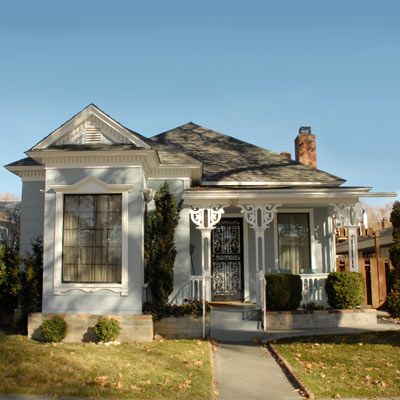
“It’s cuter than hell,” Jack Hursh says of the early-20th-century bungalow he owns here in Powning’s Addition. In fact, there are lots of cute houses to go around in this historic neighborhood just west of downtown Reno. Founded in 1888 by C.C. Powning, a transplant from Wisconsin, the area was once popular among turn of-the-century Italian-American immigrants, who took full advantage of the spacious lots the houses offered, planting them with vegetable gardens and the occasional small vineyard. After a rough patch in the 1970s and ’80s, young professionals and retirees starting moving here, and they worked together to fix up its long-neglected properties. “It’s pretty quaint now,” says Jack. “And there’s something to living in a smaller house—and not having a long commute to Reno.”
The Houses
Most were built between the late 1880s and 1920. Queen Annes and brick Craftsman bungalows dominate the mix. Jack bought his bungalow—with its original mahogany woodwork—for just $77,000, and all he really had to do was update the house’s only bathroom.
Why Buy Here?
Hundred-year-old homes for less than $100,000 bucks? That’s good enough for us.
Among the best for: West and Northwest, Cottages and Bungalows, Victorians, Waterfront, College Towns, Singles, Retirees, Easy Commute, Walkability, Outdoor Activities, Gardeners
Lambertville, New Jersey
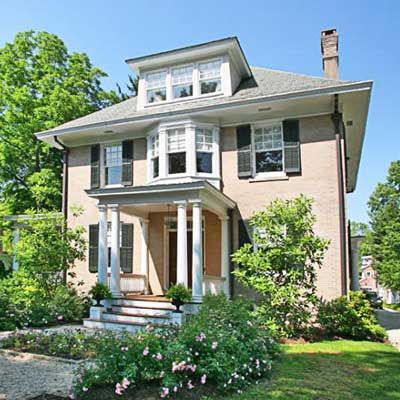
Everything from hairpins to toilets was once manufactured in tiny Lambertville. But the former industrial center has changed: This Delaware River enclave is now home to nearly 5,000 artists, writers, retirees, shop owners, and big-city professionals (who brave 45- or 90-minute commutes to Philadelphia or Manhattan, respectively). What Lambertville lacks in population it makes up for in house-reviving spirit. It’s a hotbed for carpenters, masons, architects, antiques dealers, and other home-restoration pros, and a destination for those embarking on the endearingly prickly journey of rehabbing an old home. Mornings, you can stroll the Union Street antiques shops or the nearby renowned Golden Nugget Antique Market.
The Houses
A history dating back to 1705 means Lambertville has accumulated a wide range of architectural styles. “Every house is unique,” says Holly Havens, a real estate agent who settled in Lambertville in 1995. The town center offers early-19th-century Federal to Greek Revival and later Italian Villa, Gothic Revival, English Cottage, French Second Empire, and Queen Anne homes, as well as 1850s rowhouses built for Irish canal workers. Craftsman bungalows and vernacular cottages dot outlying hills. Those game for heavy lifting can grab a storied house with good bones for a song. We found a two-bedroom Colonial rowhouse dating to the 1700s for $168,000 (yep, it needs work).
Why Buy Here?
If you’re looking for a small—but growing—artisan-friendly town, or a commutable rural pocket, Lambertville is your place. “It’s Oz,” says Havens. “We’re so tucked away.” And did we mention the deals?
Among the best for: The Northeast, Bargains, Waterfront, Retirees, Singles, First-Time Buyers, Small Towns, Outdoor Activities, Walkability
Bay Ridge, Brooklyn, New York
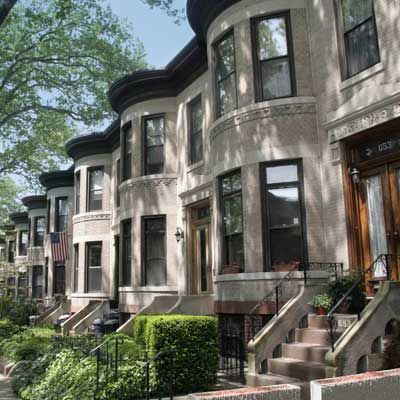
Once home to thousands of Norwegian shipbuilders as well as Italian and Irish immigrants, this old-school Brooklyn neighborhood on New York Harbor’s shores is a down-home kind of place. Families walk together after church on Sundays or gather at the locally owned restaurants and bakeries that line Third Avenue. This is a serenely diverse neighborhood, where you can hit a Norwegian pastry shop, an Italian butcher, and a Middle Eastern grocery all on one block; and it offers great views of the Verrazano-Narrows Bridge. “We like things subdued here,” says Victoria Hofmo, who grew up in the community of 70,000. “We also like all the green space, the waterfront access, and the village atmosphere. We’ve got it all.”
The Houses
Two- and three-story single- and multi-family brick and brownstone rowhouses are common, as are wood-and-stucco Tudor-style and limestone-front Renaissance Revival rowhouses. This is New York City, of course, where “affordable” means anything under seven figures. A two-story brick rowhouse with original millwork and pocket doors might go for $500,000. A restored 1930s Tudor rowhouse recently listed at $558,000. Renaissance Revivals start at $700,000.
Why Buy Here?
It’s just over an hour by subway to midtown Manhattan. Young families and professionals are coming for what is now unattainable in most New York City nabes: a single-family house.
Among the best for: The Northeast, Waterfront, City Living, Family Friendly, Walkability, Rowhouses
Astoria, Oregon
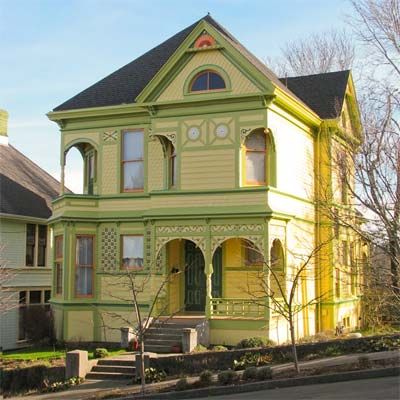
If Astoria’s old-house-lined streets look familiar, do not adjust your screen. This town of 10,000, situated at the mouth of the Columbia River, has provided a backdrop for Hollywood flicks, most notably ’80s cult classic The Goonies. Long before that, Lewis and Clark spent the winter here during their legendary expedition—and by 1811, Astoria was an established fur-trading post, then a fishing, canning, and logging center. Today’s economy has shifted toward tourism, drawn by a 1920s-era downtown and nearby sand and surf. For many locals, boating and salmon fishing are both business and pleasure. “In the summer there are days when it looks like you could hop from boat to boat,” says Regina Willkie, resident and Chamber of Commerce employee.
The Houses
With nearly 70 percent of the town’s housing stock eligible for Historic Landmark status, Colonial Revival and kit-built Craftsman homes tend to be better bargains, selling move-in ready for less than $200,000. Harder to come by are hilltop Queen Annes and Italianate “painted ladies,” such as one 5,000-plus-square-foot gal that carries a $549,000 price tag but boasts a Columbia River panorama stretching from Tongue Point to the Astoria Bridge.
Why Buy Here?
This is Astoria’s bicentennial year, making it an ideal time to check out the place. Property values have remained strong with the recent influx of retirees, and architectural preservation is a priority here. In fact, the local community college offers an associate’s degree in historic preservation. Yep, you can fix up an old home and improve your resume at the same time.
Among the best for: The West & Northwest, Waterfront, Retirees, Family Friendly, Cottages & Bungalows, Victorians, Outdoor Activities, History Happened Here
Historic Bethlehem, Bethlehem, Pennsylvania
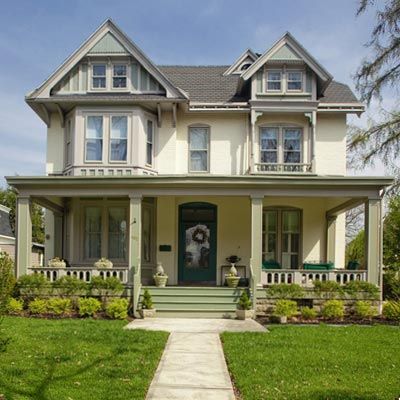
Home to America’s second-largest steel producer until Bethlehem Steel closed, in 2003, this city of 72,000 is about 70 miles north of Philadelphia and 81 miles west of New York City. Many retired millworkers still live here, these days next door to 30- and 40-something professionals who’ve chosen Bethlehem for its almost-sane metropolis commute. Lehigh University and Moravian College are both here, contributing to a thriving historic-district arts scene that includes free concerts, house and garden tours, and monthly art shows inside the glass walls of the town hall rotunda. On Main Street, the Moravian Bookshop, the country’s oldest continuously operating tome seller, stands among well-traveled restaurants and coffeehouses. Historic Bethlehem has a community feel: Neighbors attend town meetings, walk to the single-screen Boyd Theatre for a flick, and catch their dinner at Monocacy Creek, a trout stream off the Lehigh River.
The Houses
The neighborhood is stocked with two-and-a-half- and three-story Italianates, Queen Annes, Second Empires, and Gothic Revivals built near the turn of the 20th century. Got elbow grease? One of these ornate Victorians can be had starting at —300,000. A fully restored one is more likely to ring up for —600,000 or more. Historic Bethlehem also has rowhouses in the —175,000 range, and wherever you stroll, history abounds. As local Realtor Barbara Fraust says, “You can traverse centuries in eight blocks.”
Why Buy Here?
The Keystone State is known for its affordable living, for families and empty nesters alike. Retiree alert: You won’t pay state tax on pension income in good old Pennsylvania.
Among the best for: The Northeast, Waterfront, College Towns, Retirees, Family Friendly, Victorians, Walkability
South Kingstown, Rhode Island
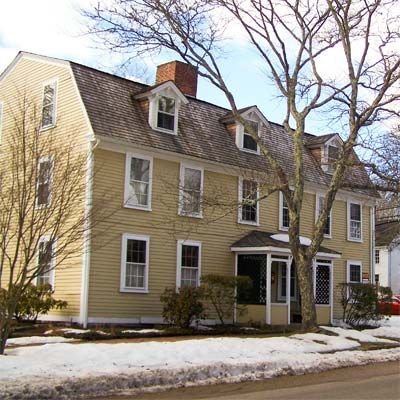
South Kingstown is a big town in a tiny state: The 57-square-mile community, just north of Atlantic inlet Point Judith Pond, comprises 14 villages, several with historical designation for exemplary architecture. South Kingstown’s jewel, the Kingston Village Historic District, founded in the 1700s as Little Rest, earned National Register standing in 1974. The neighborhood is adjacent to the 14,000-student University of Rhode Island, giving its stately blocks a vibrant energy. A bike trail follows a defunct rail line from West Kingston beachward, passing former mill sites in the villages of Peace Dale and Wakefield, where artists and academics have been colonizing old millworkers’ cottages and factory buildings. Add in good schools and shopping, and Newport or Providence within a 30-minute commute, and you’ve got a draw for all ages and professions.
The Houses
Kingston Village Historic District is home to South Kingstown’s oldest houses, ranging from Federal and other early-American styles up through the Victorian era’s Queen Annes. Peace Dale’s vernacular millworkers’ cottages charm with their picket fences and cozy front porches, and retail-heavy Wakefield hides a pocket of late-19th-century styles, including Queen Annes, Capes, Colonial Revivals and vernaculars. Recently for sale was an 1891 three-bedroom Colonial Revival in Peace Dale for $185,000.
Why Buy Here?
“It’s a lovely, preserved old town,” says Catherine Gagnon, who recently purchased a home in Kingston with business partner Ann Danis for $300,000. The two musicians plan to open Lily’s at Little Rest, a three-guest-room bed-and-breakfast. They chose South Kingstown for its possibilities, with an affordable market and supportive preservation community, as well as proximity to the beach and plenty of historic sites. “We’re excited,” Gagnon says.
Among the best for: The Northeast, College Towns, Waterfront, Family Friendly, Cottages & Bungalows, Singles, First-Time Buyers, Outdoor Activities
Yankton, South Dakota
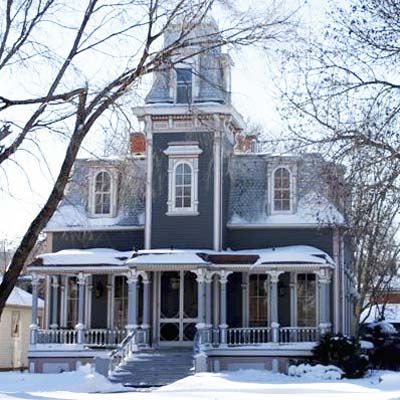
Quiet streets, fine schools, super-low crime, and the 90,000-acre Lewis & Clark Lake make this former capitol of the Dakota Territory a popular homestead for young families, retirees, and anyone else seeking old-fashioned small-town charm and inspiring natural landscapes. While the Missouri River town (population 14,000) on the Nebraska border seems sleepy, you’ll find lots of life among the pint crowd at Ben’s Brewing Company on Saturday nights and the jet-skiing constituency on the lake, which also offers swimming, camping, and hiking, and has a marina. Unlike many smaller towns, this one has jobs; about 3,000 Yanktonians work for the many hospitals and medical facilities serving the region, while others find employment in manufacturing, agriculture, or tourism.
The Houses
About 30 percent of Yankton’s houses were built from the late 1800s to about 1925. Queen Annes and Italianates are plentiful, as are Craftsman-style bungalows. We found a sturdy—and completely updated—three-bedroom Folk Victorian here for $84,900, and a beautifully conceived 1,500-square-foot brick Craftsman, packed with oak built-ins, for $89,900.
Why Buy Here?
“Well, the hunting and fishing is good, the crime rate is nonexistent, and there’s no personal income tax in South Dakota,” says former Yankton mayor Dan Specht. Obviously, we’re even more enticed by the fact that you can get a pristine old home, in a great neighborhood, for less than a hundred-thousand bucks.
Among the best for: The Midwest, Bargains, Waterfront, Retirees, Family Friendly, Cottages & Bungalows, Victorians, Outdoor Activities
Mountain View, Roanoke, Virginia
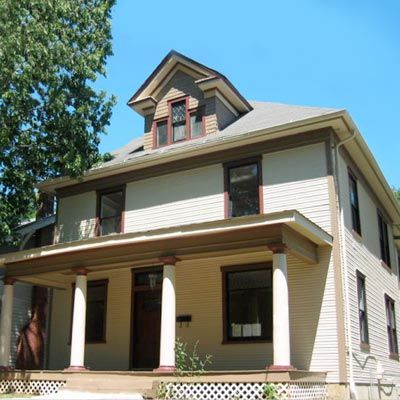
A few minutes’ drive southwest from downtown Roanoke, picturesque Mountain View is perfectly located in every respect: It’s a cinch of a commute and enjoys stunning panoramas of the Blue Ridge Mountains and the Roanoke River. It’s no wonder residents of this neighborhood spend so much time outdoors. Retirees and families enjoy soaking up the scenery along the area’s Roanoke River Greenway, a 5.5-mile paved path perfect for walking, running, and bicycling. When wintry weather moves in, the arty locals flock to the city’s galleries or mountainside wineries, or enroll in dance, music, and other “personal enrichment” classes at the Fishburn Mansion, a National Historic Landmark and community-life hub. Factor in the forty or so classic old homes—built between 1884 and 1924 to house an onslaught of railroad-industry execs—that line Mountain View’s streets, and you may just have the ultimate Roanoke Valley settling spot.
The Houses
The neighborhood’s housing stock consists predominantly of two-story American Foursquares, along with occasional Queen Annes and bungalows. A renovation movement is on the upswing, and prices and conditions run the gamut. If you’re low on cash and high on motivation, a two-story handyman special can be scored for about $35,000. Higher-end options run between $100,000 and $200,000, and are often fully renovated with preserved original details, such as pocket doors and ceramic tile.
Why Buy Here?
You’ll get a much-needed tax break. In an effort to keep Mountain View’s revitalization clipping along, preservation societies, such as the Virginia Landmarks Register, have secured significant tax exemptions for home buyers who restore historic structures—the more you sink in, the more you save.
Among the best for: The South, Bargains, Fixer-Uppers, Waterfront, Retirees, Family Friendly, Outdoor Activities, Easy Commute
The Washburn-Lawrence Neighborhood, Sturgeon Bay, Wisconsin
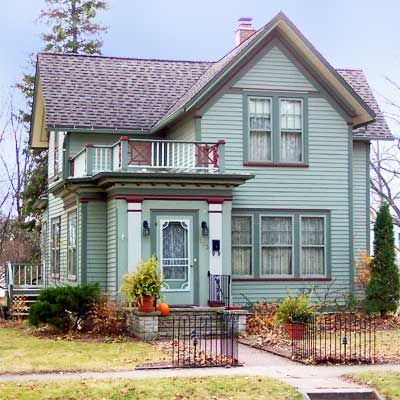
The historic Washburn-Lawrence neighborhood is in the middle of Wisconsin’s picturesque Door Peninsula, between Lake Michigan and Green Bay. It’s home to about 420 of Sturgeon Bay’s 9,700 residents. Whether they’re gardeners, boaters, or cross-country skiers, retired-age folks and family types of all ages are attracted to the area’s temperate climate; the lake and bay keep summers breezy and winters mild. Canopies of mature maples and preserved sidewalks grace the neighborhood’s residential streets, which are home only to domiciles, bed-and-breakfasts, and churches. Homey cafés, art galleries, and the old-time Third Avenue Playhouse sit just two blocks away in Sturgeon Bay’s walkable downtown area.
The Houses
Seventy-one of the neighborhood’s 180 dwellings are historic Italianates, Queen Annes, Classical Revivals, or Craftsmans, most built between 1881 and 1931. Bargain hunters with a yen for reno can find restoration-worthy options—usually in need of roof replacement and foundation work—starting around $100,000.
Why Buy Here?
A tourism hotspot, the peninsula hosts 2.2 million vacationers every year. They join locals in the orchards for apple and cherry picking, and attend tastings at local wineries. If you’ve always wanted to open a specialty shop in a quaint town or turn a historic Queen Anne into a bustling bed-and-breakfast, this may be the place for you.
Among the best for: The Midwest, Waterfront, Retirees, Family Friendly, City Living, Victorians, Gardening, Outdoor Activities, Easy Commute, Walkability
Old San Juan, Puerto Rico
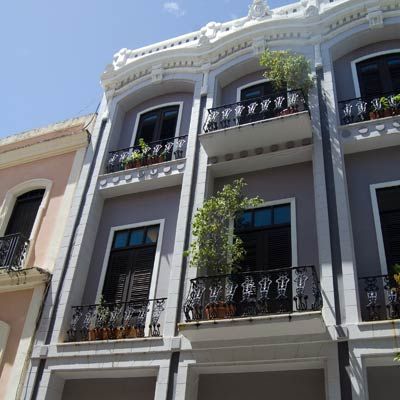
It’s said that you need to be either a poet or loco to live in Old San Juan, where Old World charm meets decidedly New World eclecticism. Packed into the winding streets of this fortified Caribbean peninsula are artists, students from three universities, shop owners, café culture knockabouts, lawyers, musicians, millionaires, government employees, and the gobierno himself, who lives in La Fortaleza; built in 1540, it’s the longest-occupied governor’s mansion in the Western Hemisphere. Neighbors chat over café con leche at places like La Bombonera every morning, and a walk on the blue-gray cobblestones, called adoquines, leads past impeccable, colorful Spanish Colonial rowhouses on par with those of Madrid.
The Houses
Restoring a Spanish Colonial, with its 2-foot-thick walls, brick-lined cisterns, and lead-pipe plumbing, is a long, involved process that is strictly overseen by the Instituto de Cultura Puertoriqueña. “They have a say inside and out, down to the hinges,” says Realtor Margarita Gandía, whose mother was one of San Juan’s first Realtors in the 1950s. A shell might go for $300,000. Homes requiring less than a gut-renovation can command $600,000. Finished, properties are worth $1 million or more.
Why Buy Here?
The upside to following strict preservation guidelines is that if the result passes inspection, you’ll pay nothing in property taxes. That status has to be renewed every 10 years, under inspection, which keeps the neighborhood in top form.
Among the best for: The South, Fixer-Uppers, College Towns, Waterfront, Retirees, City Living, Rowhouses, History Happened Here, Easy Commute, Walkability
Leslieville, Toronto, Ontario, Canada
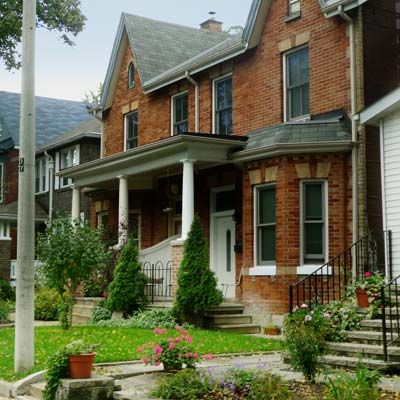
Once gritty and industrial, the east-end Toronto neighborhood of Leslieville (population: 27,000) has gained traction as families, artists, and business owners arrive in droves, lured by the fashionable scene, safe and walkable streets, proximity to local beaches, and—at least by pricey Toronto standards—affordable housing offered here. “Leslieville has completely changed in the past three years,” says Jasmin George, who works at the children’s boutique Baby on the Hip. Hers is one of many new businesses that have opened in Leslieville in recent years, including pubs, restaurants, markets, bakeries, and a cheese shop.
The Houses
“There’s definitely something enchanting about this place,” says David Dunkelman, a Realtor who runs TorontoNeighbourhoodGuide.com. Three-story Victorian-era rowhouses with steeply pitched gables line narrow, tree-bordered streets. Prices for two-story rowhouses and vernacular-style cottages start at $300,000 (USD).
Why Buy Here?
It’s one of a few desirable nabes near Toronto’s center where a reasonably priced home can be scored. Downtown is a swift 15 minutes by car or trolley, and the nearby Lake Ontario beaches can be reached via foot or bike.
Among the best for: , Victorians, Waterfront, City Living, Family Friendly, Singles, First-Time Buyers, Easy Commute, Walkability, Bargains, Fixer-Uppers, Rowhouses
Central Halifax, Halifax, Nova Scotia, Canada
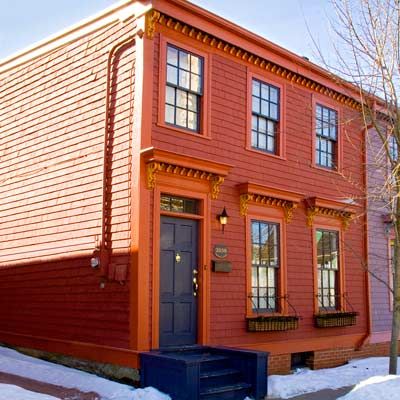
“You have to be a certain kind of person to live in Halifax,” says real-estate agent Pam Cherington. “The kind who’s concerned about quality of life.” A love of the water doesn’t hurt, either, since this so-called sleepy city of nearly 400,000 is surrounded by the stuff. Some of the most enviable old homes belong to residents of the Central Halifax neighborhood on the Halifax Peninsula, with its brightly painted townhouses and a five-minute walk to downtown and its restaurants, cafes, and brew pubs—all part of the appeal for the young professionals and growing families who move here. Halifax has a number of universities, too, so there’s a steady influx of young people, some of whom never leave.
The Houses
The draw here is the late-19th-century cedar-shingled townhouses, with high ceilings, original pine or Douglas fir millwork, and thick crown moldings. Some are two stories with flat roofs; others are two-and-a-half stories with pitched roofs and dormers. The houses, built by Nova Scotia’s sea captains, merchants, and businessmen, can be found in conditions from rundown to impeccably renovated, for prices from just north of $200,000 (USD) on up.
Why Buy Here?
The area declined during the 1980s and ’90s, but has spent the last decade as a destination for house flippers, who updated many a kitchen or bathroom. Those obsessed with attractive resale values, however, have mostly moved on, and those coming in are more likely looking to build a community and stay for the long haul.
Among the best for: Canada, Bargains, Fixer-Uppers, College Towns, Waterfront, Family Friendly, Singles, City Living, Easy Commute, Walkability, Rowhouses
Saint Andrews, New Brunswick, Canada

Hailed as the “Jewel in the Crown of New Brunswick,” this coastal village in the Bay of Fundy was one of Canada’s first pre-fab communities: British loyalists escaping persecution in the American colonies settled here in 1783, some transporting their dismantled homes for rebuilding. Late-1800s Canadian and American urbanites turned Saint Andrews into a summer playground, and the majestic Tudor-style Algonquin Hotel, built in 1889, stands today. Current residents find Saint Andrews a social place despite a high-season population of just 4,000: Locals tee off seaside, watch whales on the bay, and stroll the town’s three-mile walking loop. One thing you won’t spy here: big-box or chain stores. Local bylaws prohibit them, so Water Street’s shops are the 1880s originals.
The Houses
You’ll find Cape Cod–style cottages and other early homes put up by Saint Andrews’ first-wave settlers, and center-hall Georgians built in the 1830s. A meticulously restored 1770 Cape will set you back about $360,000; one needing TLC might list at $120,000. Big spenders: Note the $699,000 listing of New Brunswick’s most photographed home, a 1912 French Eclectic farmhouse with a harbor view and thatched-style roof and turret said to emulate explorer Jacques Cartier’s house in Brittany.
Why Buy Here?
Saint Andrews offers more house for your money compared with similar locales farther down the coast, says area real-estate agent Mark Gauley. That may be why it attracts American ex-pats and retirees looking to try out small-town living. It’s a 5-hour car ride to Boston—8 to Montreal—should you need a break from the daily waxing and waning of the 28-foot tides. We expect you won’t.
Among the best for: Canada, Bargains, Fixer-Uppers, Waterfront, Retirees, Small Towns, Outdoor Activities, Walkability
Charlottetown, Prince Edward Island, Canada
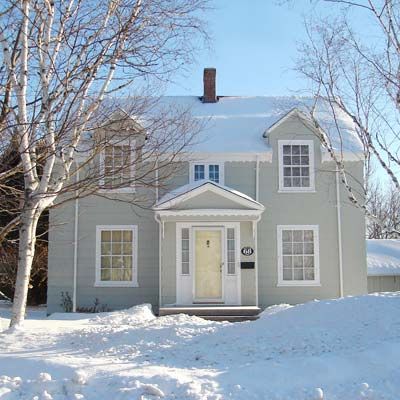
In the middle of crescent-shaped Prince Edward Island sits Charlottetown, the province’s oldest, largest city. Believe it or not, the country was born here, after an 1864 statesmen’s meeting in the city’s neoclassical Province House. Charlottetown, established as the colonial capital in 1765, contained 500 lots: five large sections carved into 100 properties each. What went up on those plots is a who’s who of domestic architecture spanning 200 years. Most structures are of the early-19th-century wood-sheathed sort, though some brick buildings recall a fire that ripped through in 1866. The city’s 33,000 residents are of all ages, here for the universities, incredible views, active lifestyle, and tourism opportunities, as well as the historical architecture.
The Houses
“Charlottetown has examples of the Georgian, Queen Anne, and Arts and Crafts styles you’d find in Britain, as well as the versions that became popular in the U.S.,” says James W. Macnutt, author of Heritage Houses of Prince Edward Island. The 500 Lots, as locals call it, is also home to Gothic Revival, Second Empire, Italianate, and a notable stock of Colonial Revivals. Diamonds in the rough may go for $120,000 (USD), but prices over a half-million aren’t rare.
Why Buy Here?
The city is experiencing growth, thanks to employers like Invesco, Ceridian, and several biotechnology companies, plus a steady stream of travelers who come for the annual SummerFest, a weeklong waterfront party for families, and the Jack Frost Festival, a winter wonderland for kids created from 2,000 tons of compacted snow.
Among the best for: Canada, Bargains, Waterfront, College Towns, Family Friendly, City Living, Victorians, History Happened Here
St. John’s, Newfoundland and Labrador, Canada
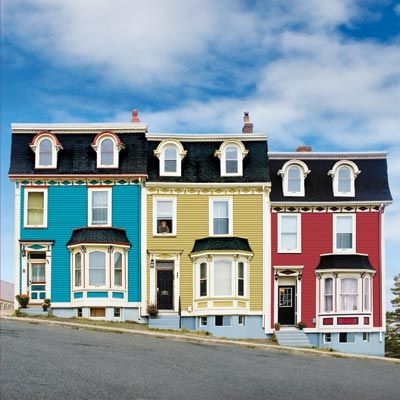
Newfoundland stands apart from Canada, an island with its own time zone, dictionary of idiomatic English, and buoyant cultural pride. The downtown district of capitol city St. John’s, built in a geographical bowl on a protected harbor, is a knot of steep streets where a local politician might live next door to a scruffy musician gigging at the Duke of Duckworth pub. Civic-minded residents boast that downtown St. John’s postal code comprises more artists per capita than any other in Canada, and the Newfoundland narrative looms large in the form of a massive gallery, archive, and cultural center called The Rooms that overlooks the area.
The Houses
“We love our ‘jelly bean’ houses,” says Dale Jarvis of the Heritage Foundation of Newfoundland and Labrador, referring to rows of three-story Second Empire rowhouses downtown. These structures hew to a remarkably consistent style, all built in the wake of an 1892 fire that burned St. John’s to a nub. Uphill, a smattering of Queen Annes and bungalows reside, perched there by merchants hoping to avoid future blazes. Thanks to offshore oil drilling in the last decade, St. John’s dodged the housing bust, but rowhouses with room for improvement can still be had for $250,000; freestanding homes list in the $500,000 range.
Why Buy Here?
You haven’t had this much fun with color since Crayola came into your life. Local company Templeton Paints has introduced a line of historic Newfoundland hues; the jelly-bean colors, embraced by owners of the downtown rowhouses, are eye candy—and instant motivation to put your paintin’ clothes on.
Among the best for: Canada, Fixer-Uppers, Waterfront, Retirees, Family Friendly, Singles, City Living, Victorians, Rowhouses, Easy Commute, Walkability
Old Town, Yellowknife, Northwest Territories, Canada
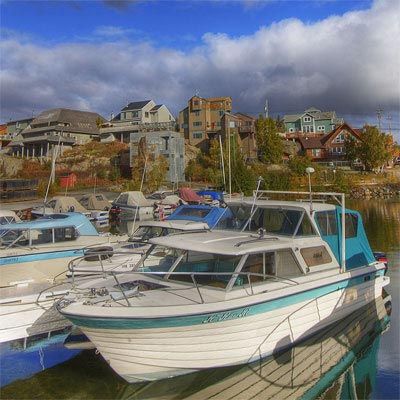
Tourists flock to Yellowknife each winter to witness the northern lights—and occasionally strip to their underwear to see if they can endure the city’s minus-40 F temperatures. “It’s adventure tourism to them,” says Elijah Forget, a lifelong resident. Despite the harsh winters, some visitors stay for the long haul. “It’s a breath of fresh air,” says Forget. “You’re so far away from urban centers and highways.” Indeed, this remote city of 20,000 between a forest and the 600-mile long Great Slave Lake is about 300 miles south of the Arctic Circle. But historic Old Town, a 1940s waterfront neighborhood established when gold rushers mobbed Yellowknife’s mines, offers companionship. Come summer, locals gather at the Wildcat Cafe to feast on daily fish specials before heading to the marina to fetch their boats for a lazy day on the lake.
The Houses
Some of Old Town’s houses were built by no-nonsense miners, who used local timber to build stout but sturdy log cabins. Many of those remaining have been clad in vinyl or clapboard siding. Prices range from $250,000 (USD) for a major fixer-upper up to $700,000 for a house that’s been renovated with additions and modern amenities. Old Town also has a well-established houseboat community.
Why Buy Here?
The last gold mine shut down a decade ago, but Yellowknife’s economy has found new life in diamond mines. This is the capital of the Northwest Territories, so there are government jobs here, too. Yellowknife has one of the highest family income rates, and lowest unemployment rates, in Canada.
Among the best for: Canada, Fixer-Uppers, Waterfront, Outdoor Activities
Dawson City, Yukon Territory, Canada
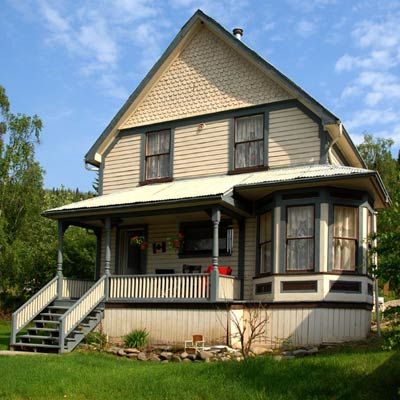
“If you’re looking for a town with historic buildings, you came to the right place,” says Bill Holmes, casino manager at Diamond Tooth Gerties Gambling Hall. Indeed, the town boasts more than 100 houses from the gold rush days along Front Street and the picket-fence-lined back lanes. Founded in 1896 at the confluence of the Yukon and Klondike rivers, the Klondike Gold Rush’s former epicenter is experiencing another boom, thanks to a recent discovery of gold south of town. The other treasure comes from the pockets of 60,000 annual tourists, who gawk at the aurora borealis, attend Dawson City’s art, music, and film festivals, tour writer Jack London’s cabin, and peruse the work of local artists. The hubbub recedes during the frigid winters, when the permanent population of about 1,800 takes to hosting cozy dinner parties. Moosso buco, anyone?
The Houses
The city’s housing heritage includes frontier vernacular-style homes gussied up with Edwardian and Victorian architectural frills such as patterned shingles and columned porches, and often girded with corrugated-metal roofs. Many of the cheery colored homes stand on wood cribbing that allows for re-leveling when the permafrost heaves, and cost from $175,000 to $300,000.
Why Buy Here?
Aside from the chance to strike it rich, owners of historic properties can apply for a matching grant from Yukon Territory: up to $10,000 a year for exterior preservation or $20,000 for an officially designated historic property.
Among the best for: Canada, Waterfront, Victorians, Small Towns, Outdoor Activities, History Happened Here
